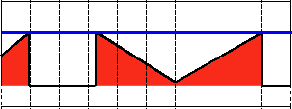Opencv学习笔记(三)基本阈值处理操作
1.什么是阈值操作?

为了从一副图像中提取出我们需要的部分,应该用图像中的每一个像素点的灰度值与选取的阈值进行比较,并作出相应的判断。(注意:阈值的选取依赖于具体的问题。即:物体在不同的图像中有可能会有不同的灰度值。)
2.阈值化的类型:
OpenCV中提供了阈值函数:threshold()函数。函数作用:根据阈值和所选择的阈值化类型,将阈值上下的像素值分别置0或255实现二值化的效果。
函数原型: void threshold(InputArray src,OutputArray dst,double thresh,double maxval,int type)
参数说明:
src:输入的源图像
dst:输出图像
thresh:阈值的大小
maxval:第五个参数的最大值
type:阈值化类型,可填入数字1~5.不同数字对应的阈值化类型:

1.THRESH_BINARY
![]()

在运用该阈值类型的时候,先要选定一个特定的阈值量,比如:125,这样,新的阈值产生规则可以解释为大于125的像素点的灰度值设定为最大值(如8位灰度值最大为255),灰度值小于125的像素点的灰度值设定为0。
2.THRESH_BINARY_INV
![]()

相当于第一个阈值化类型的取反。
3.THRESH_TRUNC
![]()

同样首先需要选定一个阈值,图像中大于该阈值的像素点被设定为该阈值,小于该阈值的保持不变。(例如:阈值选取为125,那小于125的阈值不改变,大于125的灰度值(230)的像素点就设定为该阈值)。
4.THRESH_TOZERO
![]()

先选定一个阈值,然后对图像做如下处理:1 像素点的灰度值大于该阈值的不进行任何改变;2 像素点的灰度值小于该阈值的,其灰度值全部变为0。
5.THRESH_TOZERO_INV
![]()

与第四个阈值化类型判断的情况相反。
3.基础阈值处理操作
实现代码:
#include
#include
#include
#include
using namespace cv;
Mat src, gray_src, dst;
int threshold_value = 127;
int threshold_max = 255;
int type_value = 1;
int type_max = 4;
const char* output_title = "binary image";
void Threshold_Demo(int, void*);
int main(int argc, char** argv) {
src = imread("C:/Users/86159/Desktop/yasina.jpg");
namedWindow("input image", WINDOW_AUTOSIZE);
moveWindow("input image",50,0);
namedWindow(output_title, WINDOW_AUTOSIZE);
moveWindow(output_title, 800, 0);
imshow("input image", src);
createTrackbar("Threshold Value:", output_title, &threshold_value, threshold_max, Threshold_Demo); //创建阈值滑动条
createTrackbar("Type Value:", output_title, &type_value, type_max, Threshold_Demo);
Threshold_Demo(0, 0); //创建阈值化类型滑动条
waitKey(0);
return 0;
}
void Threshold_Demo(int, void*) {
cvtColor(src, gray_src, COLOR_BGR2GRAY);
threshold(src, dst, threshold_value, threshold_max, type_value); //阈值化函数
imshow(output_title, dst);
}



